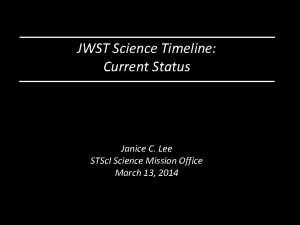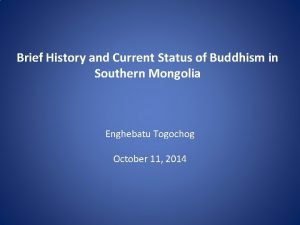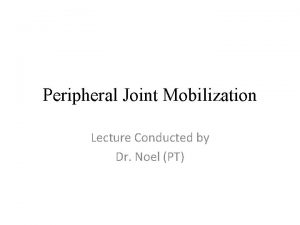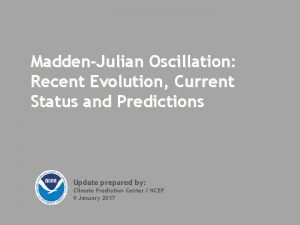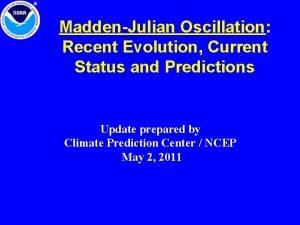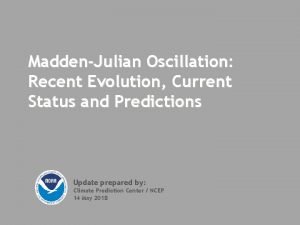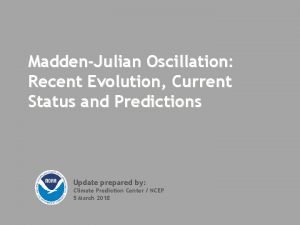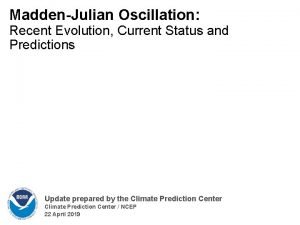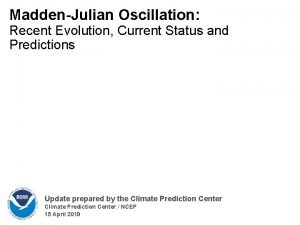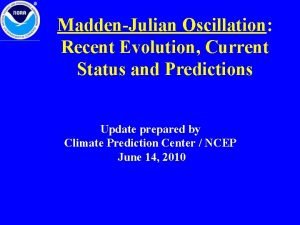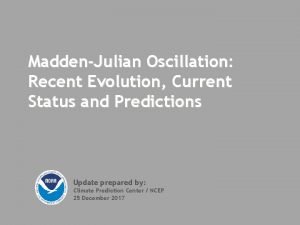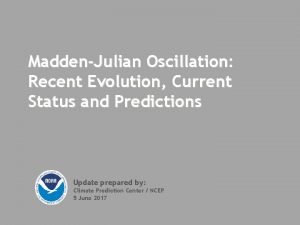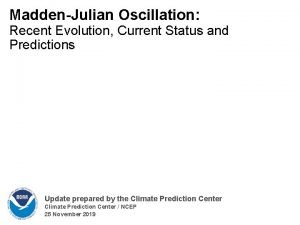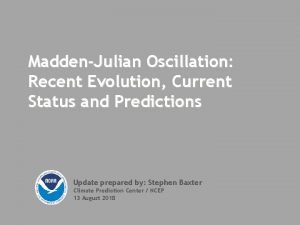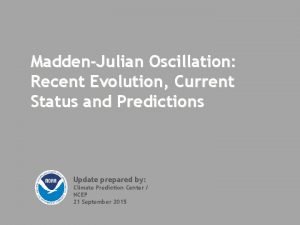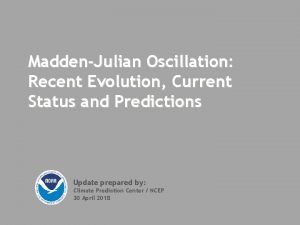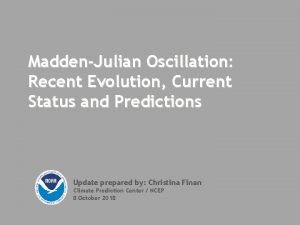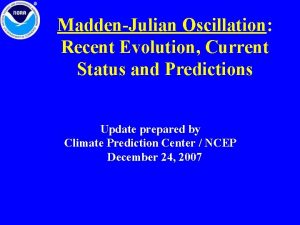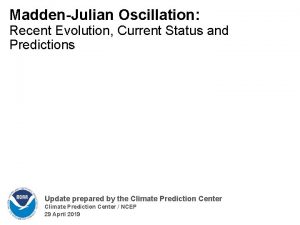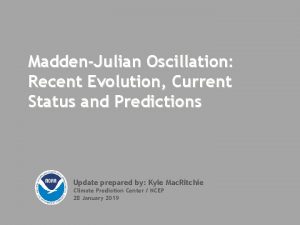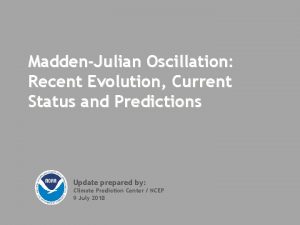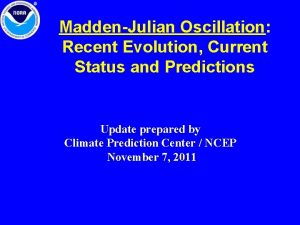MaddenJulian Oscillation Recent Evolution Current Status and Predictions





















- Slides: 21

Madden-Julian Oscillation: Recent Evolution, Current Status and Predictions Update prepared by: Climate Prediction Center / NCEP 12 December 2016

Outline Overview Recent Evolution and Current Conditions MJO Index Information MJO Index Forecasts MJO Composites

Overview Both the RMM-based and CPC velocity potential-based MJO indices indicate weakened MJO activity over the past 1 -2 weeks. There remains considerable other coherent tropical subseasonal variability contributing to the pattern of anomalous tropical convection in addition to background La Nina conditions. Dynamical model forecasts of the RMM index and statistical forecasts of the MJO predict predominately weak MJO activity over the next two weeks but some potential exists for the enhancement of convection across the western Pacific during Week-2. The evolution of the tropical intraseasonal signal over the next 1 -2 weeks is highly uncertain making it difficult to reliably state both potential tropical and extratropical impacts linked to the MJO. Additional potential impacts across the global tropics and a discussion for the U. S. are available at: http: //www. cpc. ncep. noaa. gov/products/precip/CWlink/ghazards/index. php

850 -h. Pa Vector Wind Anomalies (m s-1) Note that shading denotes the zonal wind anomaly Blue shades: Easterly anomalies Red shades: Westerly anomalies Anomalous westerlies continue over most of the equatorial Indian Ocean and Maritime continent consistent with the lowfrequency background state.

850 -h. Pa Zonal Wind Anomalies (m s-1) Westerly anomalies (orange/red shading) represent anomalous west-to-east flow Easterly anomalies (blue shading) represent anomalous east-to-west flow During June, westerly anomalies were persistent over the Indian Ocean (IO), with higher frequency modes periodically propagating across the Pacific. During late August, westerly anomalies were evident across the IO and western Pacific. During September and October, persistent westerly (easterly) anomalies were evident over the eastern Indian Ocean and western Maritime Continent (central Pacific). These anomalies are low frequency in nature, and reflect a developing La Niña base state as well as a negative phase of the Indian Ocean Dipole (IOD). In early December, westerly anomalies continued to persist across the Indian Ocean but also increased in coverage and intensity (red box).

OLR Anomalies – Past 30 days Drier-than-normal conditions, positive OLR anomalies (yellow/red shading) Wetter-than-normal conditions, negative OLR anomalies (blue shading) During mid November, enhanced (suppressed) convection was observed over the Maritime Continent (equatorial Pacific basin). This activity was primarily associated with the base state. The low-frequency base state continued to influence the pattern of anomalous convection in late November, but subseasonal variability resulted in an increase in convection over portions of Africa and the Indian Ocean during the period. In early December, a tripole of anomalous convection returned to the Indian-Pacific Ocean region with suppressed convection evident across the western Indian and central Pacific Oceans and enhanced convection noted over the Maritime continent.

Outgoing Longwave Radiation (OLR) Anomalies (7. 5ºS - 7. 5ºN) Drier-than-normal conditions, positive OLR anomalies (yellow/red shading) Wetter-than-normal conditions, negative OLR anomalies (blue shading) Several intraseasonal events were observed through July, with other modes such as tropical cyclone activity also influencing the pattern. A low frequency state favoring enhanced convection shifted slowly east from the eastern Indian Ocean to the Maritime Continent has been evident since July (green box). Low-frequency suppressed convection, tied to building La Niña conditions, has been apparent near the Date Line since late July (black box). A fast eastward propagating convective envelope was evident during early September. More recently, faster moving modes (Kelvin waves, possibly MJO) were evident in the OLR field.

200 -h. Pa Velocity Potential Anomalies (5ºS - 5ºN) Positive anomalies (brown shading) indicate unfavorable conditions for precipitation Negative anomalies (green shading) indicate favorable conditions for precipitation From June through early August, an eastward propagating signal was evident, with multiple periods of variability apparent. During August, the intraseasonal signal became less coherent, with a weaker and somewhat more stationary anomaly field in place. By late August and early September, there was renewed propagation of the intraseasonal signal. From mid-September to late October, the low frequency signal dominated the pattern. An absence of intraseasonal variability during that period resulted in the standing negative velocity potential anomalies near 120 E associated with the negative IOD event. During November, rapid eastward propagation has been observed consistent with MJO activity on the fast end of the intraseasonal spectrum, with negative anomalies most recently returning to the Maritime Continent.

IR Temperatures (K) / 200 -h. Pa Velocity Potential Anomalies The spatial pattern of upper-level velocity potential anomalies highlights anomalous divergence over the Maritime Continent with primarily positive velocity potential anomalies elsewhere of slightly lower amplitude over most of the remainder of the Tropics. Positive anomalies (brown contours) indicate unfavorable conditions for precipitation Negative anomalies (green contours) indicate favorable conditions for precipitation

200 -h. Pa Vector Wind Anomalies (m s-1) Note that shading denotes the zonal wind anomaly Blue shades: Easterly anomalies Red shades: Westerly anomalies Anomalous divergence of the zonal component of the upper-level wind field is evident over the Maritime Continent recently. C Westerly anomalies persisted over the western Pacific during the period with a well established cyclonic circulation north of the equator near the Date Line.

200 -h. Pa Zonal Wind Anomalies (m s-1) Westerly anomalies (orange/red shading) represent anomalous west-to-east flow Easterly anomalies (blue shading) represent anomalous east-to-west flow During July, some eastward propagation in large scale anomalies was evident, although the spatial consistency implies higher frequency variability than expected with MJO activity. During September, eastward propagation of westerly anomalies was broadly consistent with organized MJO activity. During November, anomalous westerlies persisted near the Date Line, though intraseasonal variability associated with the MJO is evident. Most recently in December, easterly anomalies have re-emerged across the Indian Ocean consistent with the passage of subseasonal activity and the re-alignment of the low frequency base state (red box).

Weekly Heat Content Evolution in the Equatorial Pacific Oceanic Kelvin waves have alternating warm and cold phases. The warm phase is indicated by dashed lines. Downwelling and warming occur in the leading portion of a Kelvin wave, and upwelling and cooling occur in the trailing portion. Downwelling events were observed through early February, resulting in persistently above-normal heat content from the Date Line to 80 W over that period. An eastward expansion of below average heat content over the western Pacific is evident since January, with widespread negative anomalies building across the Pacific over the course of the spring and summer months. The strongest negative anomalies now persist in the East Pacific as the negative oceanic heat content anomalies have decreased across the central Pacific.

MJO Index -- Information The MJO index illustrated on the next several slides is the CPC version of the Wheeler and Hendon index (2004, hereafter WH 2004). Wheeler M. and H. Hendon, 2004: An All-Season Real-Time Multivariate MJO Index: Development of an Index for Monitoring and Prediction, Monthly Weather Review, 132, 1917 -1932. The methodology is very similar to that described in WH 2004 but does not include the linear removal of ENSO variability associated with a sea surface temperature index. The methodology is consistent with that outlined by the U. S. CLIVAR MJO Working Group. Gottschalck et al. 2010: A Framework for Assessing Operational Madden-Julian Oscillation Forecasts: A CLIVAR MJO Working Group Project, Bull. Amer. Met. Soc. , 91, 1247 -1258. The index is based on a combined Empirical Orthogonal Function (EOF) analysis using fields of near-equatorially-averaged 850 -h. Pa and 200 -h. Pa zonal wind and outgoing longwave radiation (OLR).

MJO Index – Recent Evolution The axes (RMM 1 and RMM 2) represent daily values of the principal components from the two leading modes The triangular areas indicate the location of the enhanced phase of the MJO Counter-clockwise motion is indicative of eastward propagation. Large dot most recent observation. Distance from the origin is proportional to MJO strength Line colors distinguish different months The MJO index remained low in amplitude during the past week.

MJO Index – Historical Daily Time Series Time series of daily MJO index amplitude for the last few years. Plot puts current MJO activity in recent historical context.

Ensemble GFS (GEFS) MJO Forecast RMM 1 and RMM 2 values for the most recent 40 days and forecasts from the ensemble Global Forecast System (GEFS) for the next 15 days light gray shading: 90% of forecasts dark gray shading: 50% of forecasts At the current time, the GFS ensemble forecast depicts a generally incoherent MJO signal for the next two weeks. Yellow Lines – 20 Individual Members Green Line – Ensemble Mean

Ensemble GFS (GEFS) MJO Forecast Spatial map of OLR anomalies for the next 15 days The GEFS plot of MJO related OLR anomalies is unavailable at this time. The prediction for OLR anomalies over the next two weeks based on the GEFS RMM forecast indicates weak conditions over the period. Figures below show MJO associated OLR anomalies only (reconstructed from RMM 1 and RMM 2) and do not include contributions from other modes (i. e. , ENSO, monsoons, etc. ) Time-longitude section of (7. 5°S-7. 5°N) OLR anomalies - last 180 days and for the next 15 days The GEFS plot of MJO related OLR anomalies is unavailable at this time.

Constructed Analog (CA) MJO Forecast Figures below show MJO associated OLR anomalies only (reconstructed from RMM 1 and RMM 2) and do not include contributions from other modes (i. e. , ENSO, monsoons, etc. ) Spatial map of OLR anomalies for the next 15 days Time-longitude section of (7. 5°S-7. 5°N) OLR anomalies - last 180 days and for the next 15 days The prediction for OLR anomalies based on the Constructed analog RMM forecast indicates weak MJO activity. Enhanced convection slowly shifts from the eastern Indian Ocean to the far western Pacific while suppressed convection enters the Indian Ocean by the end of Week-2.

MJO Composites – Global Tropics 850 -h. Pa Velocity Potential and Wind Anomalies (Nov - Mar) Precipitation Anomalies (Nov - Mar)

U. S. MJO Composites – Temperature Left hand side plots show temperature anomalies by MJO phase for MJO events that have occurred over the three month period in the historical record. Blue (orange) shades show negative (positive) anomalies respectively. Right hand side plots show a measure of significance for the left hand side anomalies. Purple shades indicate areas in which the anomalies are significant at the 95% or better confidence level. Zhou et al. (2011): A composite study of the MJO influence on the surface air temperature and precipitation over the Continental United States, Climate Dynamics, 1 -13, doi: 10. 1007/s 00382 -011 -1001 -9 http: //www. cpc. ncep. noaa. gov/products/precip/CWlink/MJO/mjo. shtml

U. S. MJO Composites – Precipitation Left hand side plots show precipitation anomalies by MJO phase for MJO events that have occurred over the three month period in the historical record. Brown (green) shades show negative (positive) anomalies respectively. Right hand side plots show a measure of significance for the left hand side anomalies. Purple shades indicate areas in which the anomalies are significant at the 95% or better confidence level. Zhou et al. (2011): A composite study of the MJO influence on the surface air temperature and precipitation over the Continental United States, Climate Dynamics, 1 -13, doi: 10. 1007/s 00382 -011 -1001 -9 http: //www. cpc. ncep. noaa. gov/products/precip/CWlink/MJO/mjo. shtml
 Line currents
Line currents Phase to phase voltage
Phase to phase voltage Drift current and diffusion current in semiconductor
Drift current and diffusion current in semiconductor Line current and phase current
Line current and phase current Drift current
Drift current What is diffusion current and drift current
What is diffusion current and drift current Wye and delta connections
Wye and delta connections Slideplayer
Slideplayer Diffusion current density
Diffusion current density Different method of size sepration are
Different method of size sepration are The jfet always operates with
The jfet always operates with Amperage can be described as
Amperage can be described as Hazard based safety engineering
Hazard based safety engineering Kcl mesh analysis
Kcl mesh analysis Cpsr register diagram
Cpsr register diagram Jwst current status
Jwst current status Current status of buddhism
Current status of buddhism Periodic motion examples images
Periodic motion examples images Non-thrust oscillation techniques
Non-thrust oscillation techniques Peripheral joint mobilization
Peripheral joint mobilization Dynamics
Dynamics Graded oscillation techniques
Graded oscillation techniques















